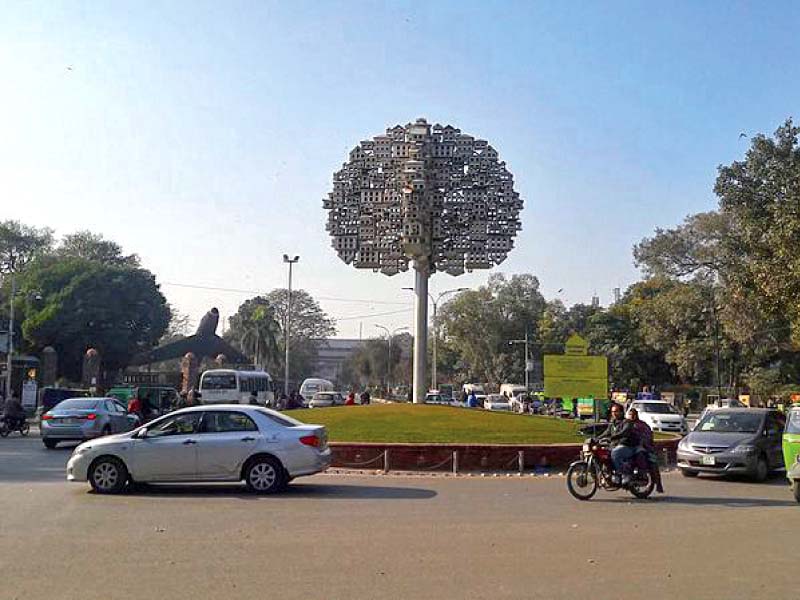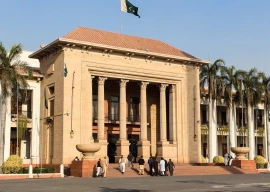
Since Pakistan came into being, different governments tried to employ “efforts” to preserve the road but all steps turned out to be futile. In fact, whenever the topic is brought up, state institutions resort to shifting blame on each other instead of owning their part.
“The renovation and maintenance of the Mall Road is not solely the responsibility of the Lahore Metropolitan Corporation (LMC) but all the concerned state departments are required to perform their duties to retain the original condition of the historic buildings situated there,” the chief officer of the LMC Muhammad Tamanna told The Express Tribune.
In the past, the concerned authorities had decided to restore the Governor House, Punjab Assembly, Masjid-e-Shuhada, WAPDA House and Bank Al-Falah, along with six other historic buildings to their original states, but restoration work is still pending.
Historical significance
Constructed in 1887 during British rule, the Mall Road is by far the most famous street in the city. It is 6.5 kilometres long and extends from Lahore all the way to the cantonment area. The road is surrounded by important government and privately-owned buildings that exude antiquity through their Mughal and British architectural design.
Some of the important structures situated on the road serve as unique examples of English architecture. These include the Government College University, Town Hall, the Supreme Court, GPO, the English Club which is now called the Punjab Club, PWD Works, Bank of Bengal, which has now been converted to the University of Veterinary and Animal Sciences Lahore, Punjab University Old Campus, the Tollinton Market, the Cathedral school, the Roman Catholic school and the Aitchison College.
Inconsistent restoration and maintenance efforts
Restoration and preservation efforts made during various tenures failed because of which the historical road has been marred by garbage, dilapidated and under-constructed buildings and encroachments. Traders and merchants have also held the Lahore Metropolitan Corporation and other state institutions responsible.
The Lahore Metropolitan Corporation has imposed a ban on constructing new buildings on Mall Road to retain the antiquity of the old structures. Still, illegal buildings have been constructed various times, only to be demolished later.
In the past, Kamran Lashari, the former director general of the Parks and Horticulture Authority (PHA), assigned the task of restoring the Mall Road to its original condition to Asif Zaheer, the director of the heritage department. As a result, all the buildings were revamped and reconstructed, the sizes of the signboards were fixed and the condition of the area significantly improved.
However, many of the tasks could not be completed as the officers in charge of the renovation works were changed – together with the priorities of the governments. After a short span of time, the condition of the road worsened as big sign boards, encroachments, and illegal construction started appearing on the road to destroy the historical aura of the Mall Road.
The practice continued until 2018, after which former justice High Court Ali Akbar Qureshi issued directives to revamp, reconstruct and maintain the original condition of the Mall Road. According to the directives, buildings on the road had to be painted anew, small signboards had to be replaced with bigger ones and encroachments had to be removed. A ban on smoking cigarettes and spitting paan on the walls was also imposed.
The work continued expeditiously as long as Justice Ali Akbar Qureshi remained in his position. However, soon after his retirement, governmental departments demonstrated their sluggishness and ignored the historical road once again. The Lahore Metropolitan Corporation even allocated Rs10 million to reconstruct and revamp the Mall Road and distributed the task to different zones, including Nishtar Town, Gulberg, Ravi and Data Ganj Bakhsh.
At present, renovation work is underway in the Pakistan Insurance Corporation Building, Ghulam Rasool Building, Bawa Dinga Singh Building, Hafeez Chamber, MHC building, Public Motor Building, and the 71 Mall Road building.
Speaking on the matter, president of the Mall Road Traders Association Sohail Butt told The Express Tribune that even though the responsibility to clean, reconstruct and clear the Mall Road of encroachments lied with the Metropolitan Corporation, the traders opted for a self-help principle and painted the buildings situated at the Mall Road themselves.
LHC’s Muhammad Tamanna, however, listed the tasks performed by the KMC and he said that the corporation has cleared the encroachments from the Mall Road, got the billboards removed, and adorned the buildings by painting them anew. “[The KMC has performed its duties but] the Lahore Waste Management Company is responsible for maintaining the cleanliness of the city and stopping citizens from littering,” he said.
“The ongoing renovation work on the buildings will be completed by the end of July 2019, whereas an operation against illegal construction has already been launched.”
Published in The Express Tribune, July 9th, 2019.

1737156099-0/Denis-Law-(1)1737156099-0-165x106.webp)











1732012115-0/Untitled-design-(14)1732012115-0-270x192.webp)









COMMENTS
Comments are moderated and generally will be posted if they are on-topic and not abusive.
For more information, please see our Comments FAQ